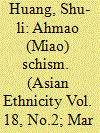| Srl | Item |
| 1 |
ID:
151480


|
|
|
|
|
| Summary/Abstract |
The majority of Ahmao in southwest China have been Christian since a mass conversion movement took place in the 1900s. Throughout the century, Ahmao congregations have gone through several reforms and survived many political campaigns. After two decades of prosperity through China’s reform era, since the 2000s many Ahmao congregations in northern Yunnan have experienced schisms. This paper sets out to investigate a schism that took place in a medium-size Ahmao congregation between 2005 and 2015. Based upon several years of continuous fieldwork, I found that the alleged schism in this Ahmao congregation – rather than describing a long-standing fracture in the community – appears intermittently and should be considered as an effect of religious regulation that problematizes the agency of spiritual practice. Under the regime of religious regulation in contemporary China, Ahmao congregations have been delicately negotiating between different modes of agency as changes in Christian practice become necessary or inevitable.
|
|
|
|
|
|
|
|
|
|
|
|
|
|
|
|
| 2 |
ID:
178470


|
|
|
|
|
| Summary/Abstract |
This article aims to provide a more complete and dynamic account of the legal framework that underpins religious regulation in Central Asia from independence in 1991 through 2018, focusing on Kyrgyzstan, Tajikistan and Uzbekistan. In contrast to existing approaches that rely on a few key laws, high-profile events or secondary sources, our analysis includes the entire body of legal documents available in government digital legal data repositories. We find that although these three Central Asian states’ approach to religious regulation has become more repressive over time, they have done so at very different paces and to very different degrees. While they have all increasingly restricted religious belief and practice that falls outside state-approved interpretations of Islam, the turn towards criminalization was much quicker and more blatant in Uzbekistan than in Kyrgyzstan and Tajikistan, and has been much more absolute in Uzbekistan and Tajikistan relative to Kyrgyzstan.
|
|
|
|
|
|
|
|
|
|
|
|
|
|
|
|